CBlair
Diamond
- Joined
- Sep 23, 2002
- Location
- Lawrenceville GA USA
Very much enjoyed reading through this conversation. Thanks for all who participate and have a very Merry Christmas.
Charles
Charles
Follow along with the video below to see how to install our site as a web app on your home screen.
Note: This feature may not be available in some browsers.
Decided to make a fine adjustment attachment for the mill.
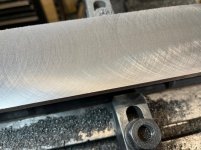
I thought it might be of interest to have some actual cut setup figures and see what is involved. It is noteworthy that there is zero chatter with those cut parameters.
Here is an image of the cross-hatch pattern produced for the final cut.View attachment 337965
FWIW,
Denis

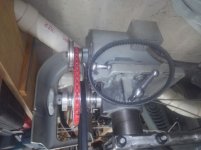
Denis, you are getting a very nice surface finish and flatness. My face cutter also came with those inserts, they tell me APMT1604 is the same as APKT1604 I was able to get a reasonable DOC when I had rigid enough clamping.
APKT and APMT inserts have the same geometry. The K vs M indicates the tightness of tolerance on the insert itself. For general work, the lower toleance inserts should be fine. However, there are tons of variations on APKT inserts with the inserts having chip breakers, radii, cutting angles etc all optimized for various materials. I am using an Ingersoll insert optimized for cast iron. It seems to hold up very well to CI when other inserts with smaller radii and sharper corners break down.
I always thought I was limited by HP on my smaller mill (3/4 hp) but when using the fly cutter I realized the problem was the belts were slipping.
The main reason I posted my cut parameters and finish result was not to say my setup is an optimal production setup. Far from it! But, I have learned to get better performance out of the diminutive BP than I initially thought possible with those improvements mainly being my own learning. A more convenient and rigid fixturing system, better inserts, a couple of reasonable (import) facemills, finding the optimal RPMs and table feed all worked together to make things work better. Most of that learning was by persistent trial and plenty of error. I also noted in an old post by Stephen Thomas his endorsement of APKT facemills as working well for him. That led me to pursue that avenue.
There was improvement when I used a prybar to tension the belts. I bought some new cogged belts but then realized the problem was the smallest diameter pulleys groves were worn to wide, anyone have any suggestion for a source of new pulleys or will I end up making new ones or perhaps modifying these?
Finding new pulleys should not be too challenging. Pulley geometry is not fixed over various pulley diameters as you may know. If you were to make new pulleys, you should read up on pulley wall angles vs belt size vs diameter. I would be much more inclined to just order pulleys from a source that provided good documentation of their pulleys that will fit a known application---I am thinking McM as opposed to ordering from eBay or Amazon. You might be able to increase your pulley sizes if you did a little figuring and changed the mating step pulley sizes. Pulleys are relatively cheap and, yes, having good ones is essential to machine performance. Maybe consider a 3-phase motor and VFD as that allows much more fine tuning of RPM. Orrrr, maybe consider a larger and more robust mill?
With the new cog belt installed and tensioned I could still make the belt slip by hand. Next I tried "power twist v belt" a link type belt which is just a little wider, and seems to fit much tighter, I cannot make it slip by hand. I look forward To trying it out with some heavy cuts.
I saw the same thing with my table saw, the pulley diameter is significantly smaller than what the belt companies recommend.
View attachment 338145
View attachment 338146
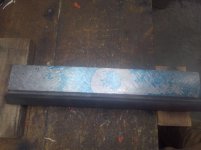






I think you are applying the blue too thick. When you get to finishing your blue should be wispy thin. Your high spots seem to wash together too much. Also, the outlines of the high spots do not appear clearly delineated. That would indicate that you're not rubbing the part hard and long enough. One way I got the ink right on the surface plate is by spreading it thin in one corner and then using a clean brayer to transfer it to another area. if you use pink granite the blue should just look like a light stain, on a black stone it should look like a light mist. Use a contrasting color on the cast, it makes the print more pronounced.
I think you are applying the blue too thick. When you get to finishing your blue should be wispy thin. Your high spots seem to wash together too much. Also, the outlines of the high spots do not appear clearly delineated. That would indicate that you're not rubbing the part hard and long enough. One way I got the ink right on the surface plate is by spreading it thin in one corner and then using a clean brayer to transfer it to another area. if you use pink granite the blue should just look like a light stain, on a black stone it should look like a light mist. Use a contrasting color on the cast, it makes the print more pronounced.

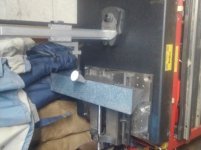
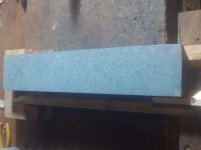

Notice
This website or its third-party tools process personal data (e.g. browsing data or IP addresses) and use cookies or other identifiers, which are necessary for its functioning and required to achieve the purposes illustrated in the cookie policy. To learn more, please refer to the cookie policy. In case of sale of your personal information, you may opt out by sending us an email via our Contact Us page. To find out more about the categories of personal information collected and the purposes for which such information will be used, please refer to our privacy policy. You accept the use of cookies or other identifiers by closing or dismissing this notice, by scrolling this page, by clicking a link or button or by continuing to browse otherwise.
